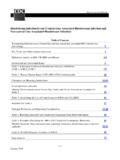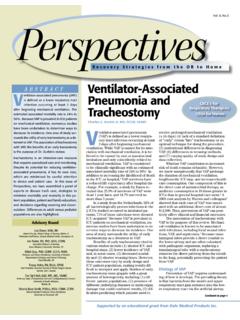Transcription of Risk assessment Methodologies - Sasom
1 Risk assessment Methodologies Presented by Mike Erasmus GradIOSHSA (SAIOSH); GradIOSH(IOSH UK). Outline 1) What is Risk assessment ? 2) Terminology 3) Why do we do a Risk assessment 4) Expectations of a Risk assessment 5) Planning your Risk assessment 6) Five Steps in carrying out a Risk assessment 7) Vulnerable Workers 8) Other Risk Methodologies Risk assessment ? Risk assessment is the procedure by which the risks posed by inherent hazards and associated risk involved in the processes or situations are estimated either quantitatively or qualitatively. Systematic process of managing risk proactively. Process of evaluating the risk(s) arising from a hazard(s),taking into account the adequacy of any existing controls, and deciding whether or not the risk(s) is acceptable (OHSAS 18001 2007). Cornerstone of OHS management system Terminology Hazard a source of or exposure to danger , or more simply something with the potential to cause harm.
2 OHSAS 18001 2007 Source, situation, or act with a potential for harm in terms of human injury or ill Health , or a combination of these Terminology RISK. Is the likelihood or probability that harm from a particular hazard may occur. Combination of the likelihood of an occurrence of an hazardous event or exposure(s) and the severity of injury or ill health that can be caused by the event or exposure(s) (OHSAS 18001 2007). WHY DO WE DO RISK. assessment ? Legal Risk averse System Requirement (Policy based decisions). Financial. Moral LEGAL REQUIREMENTS. Risk assessment forms the cornerstone of any SHE Management System. Why do you think this would be so? You cannot manage what you cannot define or do not know. This basic fact is recognised within our legislation in terms of Section 8(2) d of the OHSACT (85) of 1993, where an employer is required to establish, as far as is reasonable practicable: What hazard to the health or safety of persons are attached to any work which is performed, any article or substance with is produced, processed, used, handled, stored or transported and any plant or machinery which is used in his business and it goes on to say that, he shall, as far as is reasonably practicable, further establish what precautionary measures should be taken with respect to such work, article, substance, plant or machinery in order to protect the health and safety of persons, and he shall provide the necessary means to apply such precautionary measures.
3 OHSA Sec. 8. HIRA (Hazard Identification, Risk assessment ) - d Eliminate, mitigate before resorting to PPE b GSR 2 Articles and SELF Substances - c REGULATION. Safe: Systems, Plant, Machinery - a Sec. 13 Duty to Information, instructions, inform training, supervision - e Prohibiting employee - f Enforcement - (g - j) 10. FINANCIAL BENEFITS. Although there are costs associated with the implementation of controls, savings are also achieved. These are in the form of: Reduction in incidents and associated incident investigation and reputational costs Enhanced productivity and staff morale Reduction in waste Increase efficiency and reduced down time Legal liability MORAL REASONS. Serving as the basis for a SHE Management System, doing risk assessments forms part of an employer's moral duties to provide a healthy and safe working environment for their employees and others.
4 (Duty of Care). Furthermore, environmental resources are commodities shared with society, thus the employer has a duty to minimise the impact of the organisation on these commodities to the benefit of the community at large When should we conduct Risk Assessments The risk assessment procedure is intended for use: For existing operations where hazards appear to pose a significant threat and it is uncertain whether existing or planned controls are adequate in principle or in practice. When new plant or equipment is installed. Fire Risk Evaluation Occupational Hygiene Stressors Major Hazardous Installations installed or re-assessed by AIA. Electrical zoning surveys When should we conduct Risk Assessments (cont). Before new work is performed that is not governed by a safe working procedure. Before emergency work (out of routine activities/ non-routine).
5 Are to be performed. In pursuing continuous improvement in excess of the minimum legal requirements Risk Assessments must be reviewed after the occurrence of a significant OHSE incident. To determine those aspects that have or can have significant impact (s) on the environment ( significant environmental aspects). Acceptable risk standard Where it is clearly defined Self regulatory( Reasonably Practical). Severity and scope of hazard /risk Level of knowledge concerning hazard / risk and means of removing Suitability and availability of ways of removing hazard Cost vs. Benefit 15. Expectations of a Risk assessment The risk assessment process should be: Systematic Rigorous Structured Repeatable Consultative Outcomes of the risk assessment process should be: Defensible Auditable Suitable and Sufficient'. Proportionate to level of risk Reviews all aspects of work activity Considers work organisation Identifies significant hazards and risks Evaluates the risks Identifies control measures Enables priorities to be set Considers non-routine operations Considers risks to the public Undertaken by competent person(s).
6 Valid for a reasonable time Competent Risk Assessors Experience and training in hazard identification and carrying out risk assessments Knowledge of the process or activity Technical knowledge of the plant or equipment Good communication and report writing skills Ability to interpret legislation and guidance Positive attitude Consultative (Team Effort). Knowledge of risk assessment techniques Knowledge of the process to be assessed Ability to interpret standards Attention to detail Recording and communication skills Managerial influence to authorise and implement change WHAT DOES A FORMAL RISK assessment ENTAIL? PLANNING. Defining the scope and depth of risk ass. Clarify the methodology to be used. Resource requirements Identify and access input data Example Incident record hygiene survey ,MSDS etc. Determine documentation needs Compile an operational flow diagram Establish the duties and responsibilities of all the role players Determine training and team composition requirements Risk assessment cannot be done in isolation.
7 Outline communication and consolation process. Risk assessment team: Cross Section Operations, Technical , Unions, SHE Rep, OHP. 21. 3 Levels of Risk assessment 1) Baseline Risk assessment : Primary, Broad based: Geographical- Location of activities example welding on the ground has certain risk , the same task in a vessel or in elevated position identifies additional risk. Functional - Types of activities Pure hazards inherently dangerous 2) Issue-Based Risk assessment : New process, Equipment. New legislation changes, Accident 3) Continuous Risk assessment : Day to Day assessment , Pre start up checks, SHE Rep inspections , Operator checks. Five steps in carrying out a Risk assessment Step One: Identify Hazards Step Two: Analysis Step Three: Evaluation Step Four: Record findings Step Five: Review and update Step One: Identify Hazards Process mapping and creating a flow diagram Review input data Absenteeism records MSDS's Statistics In Situ Physical assessment in areas Interviews with operators, maintenance staff Benchmarking with other companies.
8 IDENTIFY THE HAZARDS. PHYSICAL HAZARDS: Ionizing radiation (x-rays), Noise, Lighting, Vibration, extreme temperatures, Poor ventilation. CHEMICAL HAZARDS: Acids, Pesticides, Herbicides, Fumes, Dusts, Gasses, Flammable substances, Solvents, Effluent, Solid waste, Pharmaceutical (Levothyroxine) 600 micrograms humans versus rats Chemical Physical Pharmacological Side Effects Therapeutic Effects BIOLOGICAL HAZARDS: Vermin (rats & mice), Pathogens, Viruses, HIV/AIDS, Medical waste MECHANICAL Lifts, Cutting machines, Electrical hand tools, Portable electrical equipment, Lifting equipment, Forklifts, Ladders scaffold, slip trip and falls. ERGONOMIC HAZARDS: Manual handling, Repetitive movement, Poor design, Restricted space; Outdated design & technology, work stations. Prolonged standing PSYCHO-SOCIAL HAZARDS: Shift work, Peer pressure, Alcohol / Drug misuse, Stress ENVIRONMENTAL ASPECTS: Contaminated air and water, hazardous waste, Resource use 26.
9 Identify the hazards in the following pictures Identify the hazards in the following pictures IDENTIFICATION OF HAZARDS. Brainstorming & process mapping Review input data incident history, hygiene surveys, MSDSs Physical assessment Interviews Benchmarking codes or practice/standards Don't be scared to state the obvious 31. Step Two: Analysis Decide who might be harmed & how? Operator type (Final assembly). Maintenance staff Support staff Cleaning staff Contractors Visitors Vulnerable employees Consequences SAFETY CONSEQUENCES. Consequences that are the result of direct energy transfer fall under this category. They usually result from contact between ACTIVITY 2. the person and the plant or machinery. These could include but are not limited to the following: Amputations Contusions Lacerations Unconsciousness Fractures Electric Shock Burns HEALTH CONSEQUENCES.
10 Consequences that are the result from existing conditions within the working environment fall under this category. They usually result ACTIVITY 2. from exposures to fumes, dust, chemicals, radiation, noise, poor lighting and ergonomics. These could include but are not limited to the following: Dermatitis Cancer Asbestosis NIHL. Silicosis Acute and Chronic Step 3: Evaluation (to prioritise risks for action). Quantitative risk assessments Numerical value assigned giving hazards measurable qualities to prioritize. Qualitative risk assessments Rely on experience and opinion of risk assessors and team You can not argue one risk assessments better than the next. One must keep in mind that the success of any evaluation methodology employed is measured on the outcomes it has achieved. Must pass the test of reasonably practicability.





